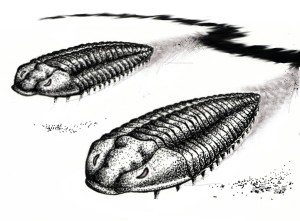
TheDarwinReport
Apologetics Press is so intellectually anorexic, it’s frightening to imagine the base level of research involved in its preparation of creationist material. It’s like watching a poorly conceived horror movie; on the one hand it’s something to laugh at, and on the other it has the occasional shock, even if it’s just a comically masked killer jumping from behind a door with an over-sized knife. It’s cheap thrills, good for a few chuckles. So, here’s today’s feature —the Apologists had something silly to say about the complexity of the trilobite eye. It begins:
One of the most fascinating finds in the fossil record is that of the long-extinct trilobite. Trilobites resided in the Earth’s ancient oceans, and often are considered to be the world’s first arthropods—creatures that consist of hard shells, and that have multiple body segments and jointed legs. Trilobites, which possessed a hard exoskeleton, bear a resemblance to horseshoe crabs, and are thought by evolutionists to be one of the first animals to have lived on the Earth. [my emphasis]
Ah, the errors run like a river: 1) Old-earth creationism invariably involves typological thinking; in other words, some group of organisms must be a “type” without the word ever being adequately defined. Here the Apologists roll the more than 20,000 species of trilobite into one type, as if they were referring to a single creature; and throughout the remainder of the article, trilobite traits are lumped on to that type with complete disregard for the immense diversity that exists within the class, Trilobita. 2) And which paleontologist claims that trilobites were the first arthropods? The first arthropods are thought to have been leggy segmented soft-bodied worms from the Early Cambrian. In fact, if you were to remove all that armor from a trilobite it would look like a worm. It’d be like peeling an artichoke, where there isn’t much underneath. 3) Next, the Apologists claim “evolutionists” think of trilobites as the “first animals to have lived on Earth”. How does it work out that trilobites were the “first arthropods” and the “first animals”? What 19th century children’s encyclopedia have these dimwitted clowns been reading? The sponges might have something to say about who the first animal was.
Let’s wallow in the rest of the Apologists’ misconceptions:
Evolution postulates that all living animals have progressed from simpler creatures, and that by the process of natural selection, organisms have “improved” along the way. Conventional thinking, therefore, suggests that since trilobites are so ancient, they must have been fairly simple creatures with primitive features. However, the eye of the trilobite—which is incredibly complex—refutes such a concept.
Yeah, well, when you disregard the tens of millions of years of natural history that occurred prior to the trilobites’ reign, it’s easy to make that argument. If no creatures with simpler eyes than trilobites had existed, then there would be a problem. But since there’s plenty of evidence to the contrary, the flaw clearly lies in the Apologists being willfully ignorant of the subject matter.
Most trilobites had a pair of compound eyes that were made up of 100 to 15,000 lenses in each eye.
Such intricacies suggest that evolution is a degenerative process, for nothing on Earth today compares to the eye of the trilobite.
Darwinian models that attempt to explain the trilobite’s eye are completely unable to account for such complexity, especially considering the fact that the trilobite is considered to have evolved so early. When one considers the complexity of the trilobite’s eye, and compares it with the considerably less-complex eye systems of animals and/or humans today, it would seem that evolution has “gone in reverse.” [my emphasis]
Additionally, they go on to quote-mine paleontologist Niles Eldredge, who only speaks to the complexity of the trilobite lens, not the entire eye. The unique characteristic of the double-layered lens (doublet) of the trilobite is that it corrects for the aberration that occurs when light travels from a less dense material like water to a more dense one like calcite (CaCO3), which is what the trilobite lens –and exoskeleton, not coincidentally– is made of. But the human lens is, in fact, more complex because it can change shape to focus, while the trilobite lens is fixed. What the Apologists don’t grasp is that evolution is adaptive and not progressive in the long term, and that the variation in nature demonstrates how many ways there are for solving the same problem. How many different types of eyes are there? Moreover, they fail to see that eyes don’t see; eyes merely collect light and convert it to signals for the brain to interpret. Are the Apologists going to argue that the trilobite brain was more complex than the human brain? They can speak for themselves –and their own brains– on this point. Are you smarter than a trilobite? Now that’s a game show I’d watch. Trilobites win every time.






